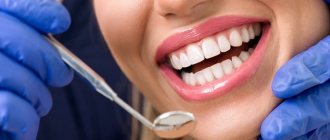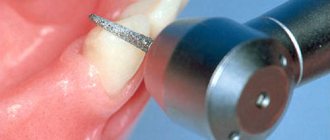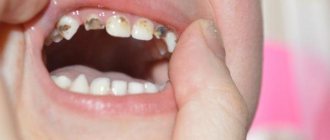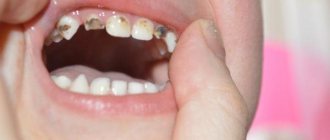People turn to the dentist when they have any problems with the health of their teeth or gums. Pain in the tooth, swelling of the gums, increased sensitivity of the teeth, bad breath - all these phenomena can appear against the background of various dental diseases and, based on the nature of the disease, the specialist selects the optimal method of dental treatment.
Whatever method of dental treatment is chosen, its main task will be to preserve all the functions and aesthetics of the tooth. Below we will look at a variety of dental treatment methods that are used in modern dentistry and will also talk about complications that can occur when errors in treatment procedures were made by the doctor.
Methods and timing of modern treatment of dental diseases
Dental treatment in modern dental clinics is a whole series of special measures to stop the development of the inflammatory process, restore all useful functions, as well as the aesthetics of the dental unit. Most often, patients turn to dentists for the treatment of dental caries, which occurs in people of all ages and in a variety of forms - from the spot stage to deep caries, when the destruction of a unit has reached almost to the root. If caries was not cured on time or its treatment was carried out in violation of the rules, complications such as pulpitis and periodontitis arise. Treatment of these dental diseases is more complex; it is carried out in stages and involves at least 2-3 visits to a specialist’s office. The timing of dental treatment always depends on the complexity of the clinical case. For example, treatment of caries in the spot stage takes place in one visit
dentist, implantation and prosthetics are divided into several stages and the treatment period is maximum - from several months to a year. Do you want dental treatment to always proceed quickly and with a minimum of discomfort? Then attend regular preventive examinations at the dentist, because it has long been known that the best dental treatment is prevention!
Why do my teeth hurt?
The main causes of toothache include:
- Caries.
The initial stage is characterized by the destruction of the upper tooth tissues. The pain occurs periodically or one-time - the tooth reacts to pressure, cold and hot. - Deep caries.
The middle tissues of the tooth are affected, the pain becomes more prolonged, aching or throbbing. - Pulpitis.
The result of untreated caries. A nerve has been hit. The pain is severe and incessant. - Periodontitis.
Inflammation of the tissues around the roots of the teeth. It occurs as a consequence of pulpitis or after erroneous medical procedures. The pain is acute, intense. - Residues of food stuck
between teeth, even healthy ones. First there is a feeling of discomfort, then a pressing pain that can cover the entire jaw. Use dental floss or metal (dental) tape.
Endodontic dental treatment: when and how is it carried out?
Endodontic dental treatment is used in practice if caries has destroyed the tooth and the inflammatory process has moved into the canals of the dental unit. When carrying out endodontic dental treatment, a specialist treats the canals: cleans the cavities from damaged tissue, rinses them with an antiseptic solution, and applies medicine. Typically, after these procedures, a temporary filling is placed on the tooth, and the patient is sent home to return to the dentist's office in a few days.
At the second visit, an x-ray of the diseased tooth is taken to evaluate the effectiveness of the treatment. If the inflammation has been stopped, the canals are treated with an antiseptic again, and then their space is filled with gutta-percha. The tooth treatment ends with the final restoration of the crown using a composite filling material.
Endodontic treatment must be carried out with high quality and using specialized modern tools: files that allow the canals to be expanded as needed, a microscope that allows the doctor to see the condition of the tissues and canals, an apex locator that shows the length of the tooth canals.
If root canal treatment is carried out incorrectly, errors are made in its technology - there are risks of serious complications that can lead to the loss of a dental unit.
Help with pulpitis
Without proper treatment, caries can develop into pulpitis. The pain syndrome with it is more pronounced, occurs without a reason, the pain intensity is very high. The attacks last a long time, they are especially pronounced at night.
You can somewhat reduce inflammation and quickly relieve toothache due to pulpitis using the same folk remedies as for tooth root abscess.
Effective recipes against pulpitis
- Add a few drops of lemon juice and twenty drops of hydrogen peroxide to half a tablespoon of baking soda. The mixture is placed in the hollow of the diseased tooth and used to numb the gums. The intensity of the pain syndrome noticeably decreases after fifteen minutes.
- Place half of the No-shpa tablet into the tooth cavity. If the inflammatory process begins under the filling, the tablet is applied to the back wall of the tooth. No-spa relieves pain gradually: as it dissolves.
Is it possible to treat teeth without a drill?
Sociological surveys show: almost 80% of people are afraid to visit the dentist due to fear of having their teeth drilled. Not only children, but also adults are afraid of drills. If you are also afraid of the need to drill a tooth for its quality treatment, then it will be useful for you to know the following fact: if you seek dental care in a timely manner during dental treatment, you can completely do without a drill!
Fluoridation
If the examination reveals caries in the stain stage, then dental treatment may involve procedures aimed at remineralizing and strengthening the enamel. Tooth surfaces are covered with special gels containing high concentrations of fluoride and calcium and, of course, this treatment is absolutely painless!
Laser treatment
Another option for dental treatment without drilling is the use of laser radiation with a wavelength of a certain length. The laser beam heats and destroys tissues destroyed by caries, and after treatment it will be enough to rinse the area of manipulation with water. The innovative method of dental treatment has many advantages, including: high efficiency of the method; low risks of complications; additional antibacterial effect. The disadvantages include the fairly high price of laser dental treatment and a wide range of contraindications. It is also worth knowing that dental treatment with laser radiation will be painless only when caries has destroyed only the tooth enamel. If the destruction has reached the deep layers of dentin and pulp, before laser dental treatment, the patient is given anesthesia to eliminate unpleasant painful sensations.
Infiltration treatment method
Dental treatment is carried out using Icon technology, which consists of treating carious cavities with a special polymer composition. The active substances in the composition uncouple and dissolve damaged tissue, the remains of which the doctor removes with an alcohol solution. Then the treated areas of the tooth are dried and treated with a polymer resin that fills micropores in the natural enamel coating of the tooth. The tooth treatment using Icon technology ends with the use of a polymerization lamp, which dries the applied composition. The advantages of this dental technique include: maintaining the integrity of the natural enamel coating for a long time, increasing the strength of tooth enamel; the ability to choose a polymer shade that exactly matches the tone of natural enamel; speed of dental treatment - the entire treatment process takes no more than half an hour; The treatment is painless and does not involve the risk of overheating of the tooth tissue.
Icon dental treatment technology is optimal for treating carious stains in the interdental spaces and is suitable for eliminating caries in children.
Ozone therapy
Another method of treating teeth without drilling is ozone therapy, which involves exposing carious cavities to ozone. The impact is carried out by a special device that converts oxygen into ozone. This gas destroys pathogenic microflora and carious bacteria. After treatment with ozone, the tooth is covered with a special gel and the treatment process ends.
Ozone therapy can be used not only to treat teeth damaged by caries. It is indicated for inflammation of the soft tissues of the oral cavity, inflammatory processes in the dental canals.
If your wisdom tooth hurts
In cases where a wisdom tooth begins to hurt, doctors recommend removing it immediately. If he starts to cut himself, then you can help yourself a little on your own. The process can take almost a year, and the gums may become inflamed, the cheek may swell, and severe pain may occur—it feels as if the entire jaw is being broken out. The temperature can also rise to 38-40°C.
- Within 4-5 days you can take analgesics in accordance with the indicated dosage.
- You can use Metrogil Dent or Dentinorm.
- Regularly, several times a day, rinse your mouth with decoctions of chamomile, sage, calendula, and oak bark.
- A warm solution of salt and soda (one teaspoon per glass of water) will help.
Features of the dental treatment process under a crown
Installing a crown does not guarantee 100% protection of the tooth from caries and other dental diseases. Some time after the installation of a prosthetic structure in the patient’s oral cavity, phenomena such as subsidence of the gums and exposure of the cervical part of the tooth may be observed. These phenomena create favorable conditions for the development of caries and the risks of developing carious lesions are especially high due to insufficient oral hygiene. Under the crown, not only caries can develop, but also pulpitis and periodontitis, and therefore if you have pain in a tooth on which a crown has been placed, you need to seek professional treatment urgently!
If the diagnosis reveals caries or an inflammatory process under the crown, tooth treatment will involve removing the orthopedic structure and carrying out all the necessary manipulations to stop the inflammation and save the tooth.
Note that caries under the crown often appears because errors were made during the manufacture of the prosthetic structure or during its installation. If the crown is adjacent to natural tissues with insufficient density, pathogenic microflora can easily penetrate under it. For this reason, it is important to choose a good dental clinic for prosthetics, which employs experienced and competent specialists.
The influence of dietary habits on caries
The destruction of the enamel structure is facilitated by the acid secreted by bacteria. It is formed in large quantities when consuming carbohydrate foods. Therefore, to prevent caries, it is necessary to limit the consumption of sweets and sugar, and after eating sweet foods, be sure to rinse your mouth.
Caries develops faster when the enamel becomes thinner. In order for teeth to be strong and less susceptible to decay, the body must receive sufficient amounts of vitamins and microelements. They can be taken as a multivitamin as prescribed by your doctor, but it is best to take them through food. To do this, the diet must be varied and balanced, it must contain dairy products, fish, cheese, and fresh herbs.
It is useful to eat solid vegetables and fruits (carrots, apples). They mechanically clean the enamel from plaque and stimulate blood flow in the gums. Avoid eating foods and drinks that are too hot or too cold. Due to temperature changes, microscopic cracks form on the enamel, which contributes to the development of caries.
The need for anesthesia before dental treatment
Anesthesia during dental treatment is not always necessary, but only in cases where the destruction has affected the deep layers of dentin. There are nerve endings in the deep layers of tooth tissue, and therefore any manipulation in this area can cause significant pain to the patient. To eliminate discomfort during dental treatment under such circumstances, anesthesia is administered before the start of the treatment process, selected individually. The anesthetic is administered by injection, but there is no need to be afraid of an injection: modern syringes have ultra-thin needles that allow you to administer the medicine quickly and painlessly.
For patients with a high pain threshold, anesthesia can be given not only before dental treatment, but also before such activities as professional cleaning of dental surfaces and whitening. Typically, topical anesthesia is chosen. General anesthesia is used in dental treatment
extremely rarely - mainly before complex and lengthy operations. It is worth knowing that general anesthesia has a number of contraindications and therefore, before choosing this anesthesia technique, the patient must undergo a series of tests.
If the tooth is loose and hurts
What to do if the tooth not only hurts, but also becomes loose - we try to relieve the pain using any of the listed methods (tablets, gels, rinsing, folk remedies). And we are planning a visit to the doctor. Perhaps carious processes have begun with simultaneous loosening of the tissues around the tooth. If you get there in time, he can be saved. Similar manifestations are possible with periodontitis, periodontal disease, and gingivitis.
Be careful. When carrying out manipulations, try to be extremely careful to prevent further loosening.
Depending on the diagnosis, the doctor will prescribe treatment, including antibiotics, vitamin therapy, and physiotherapy.
Specifics of dental treatment in the smile area
The front teeth are included in the so-called smile zone and therefore, when treating them, the aesthetics of the final result of the treatment process is fundamental. To restore an anterior tooth, the dentist must have experience in selecting shades of light-curing composites, recreating the natural shape of the tooth, and all the natural irregularities of its surface.
If the tooth located in the smile area is healthy, but there are aesthetic defects, the use of veneers may be a treatment option. Veneers are miniature plates-onlays that are glued to the surface of the teeth and ideally mask defects such as curvature of teeth, unsightly shape, darkening of the enamel, and interdental spaces. If a tooth is destroyed by more than fifty percent, restoration with a crown is indicated. A pin that is used by some specialists for severe tooth destruction
Installation is not recommended. A large filling will not withstand the load that is inevitable during chewing processes and will fall out or break off, along with part of the tooth. If the root part is affected when the filling is broken, the tooth will have to be removed. In the area of the front teeth, prosthetics made from durable and aesthetic materials are recommended: ceramics, porcelain, zirconium.
Symptoms that may indicate the need for dental treatment
If you are worried about tooth pain, even if it is mild and appears from time to time, this is a clear reason to see a doctor and undergo professional dental treatment. The sooner you contact a specialist, the less likely it is that the treatment will be complex, protracted and painful. The following symptoms may also indicate the need for urgent dental treatment: The appearance of dental hypersensitivity; sharp, unpleasant odor from the mouth (if hygienic procedures for caring for the oral cavity are carried out on an ongoing basis); bleeding, swelling of gum tissue; problems with opening/closing the mouth; the appearance of spots, irregularities on the dental surfaces, and changes in the shade of tooth enamel. Remember that a timely visit to the dentist for tooth treatment is the only way to save the tooth. And your teeth are better than any, the most modern dentures!
Good immunity reduces the risk of developing caries
The bacteria that cause tooth decay are part of the normal microflora of the oral cavity. But with weakened immunity and other accompanying factors, they can cause caries. At home, everyone can prevent this dental disease by strengthening the immune system. This is facilitated by hardening, reducing stress levels, quality sleep at night, proper nutrition, giving up bad habits, and maintaining a normal weight.
The fewer factors that weaken the immune system, the lower the risk of dental caries.
How is dental treatment performed in dentistry: an overview of the main stages
Unfortunately, most patients ignore dentists' advice on the importance of regular visits to the doctor and preventive examinations and therefore see a specialist with advanced caries, acute pain, and the presence of many different oral diseases. Therefore, dental treatment will always begin with diagnosis, and will also include the following stages:
Examination and treatment plan
An appointment with a doctor begins with an examination of the oral cavity, as well as prescribing a number of diagnostic tests for the patient. This will allow you to identify all existing dental and oral health problems and create a detailed treatment plan.
Professional sanitation of the oral cavity
It is recommended to begin dental treatment only after high-quality sanitation of the oral cavity, during which all types of plaque are removed from the dental surfaces.
Treatment
If a patient consults a doctor with medium or deep caries, dental treatment cannot be done without drilling. Using a drill, a specialist will remove all tissue damaged by the disease and create a cavity for installing a filling. Pulpitis and periodontitis imply a more complex treatment regimen, which includes canal treatment, antibiotic therapy, and some types of surgical interventions. The treatment method is selected based on the characteristics of the clinical case. The treatment of the tooth ends with the final restoration of its crown using photopolymer filling materials.
If your tooth hurts after nerve removal
Even several hours after removal of the nerve, pain may be felt in the damaged tooth - when pressing, when biting, or slightly throbbing. This is a normal reaction of the body to intervention.
What to do:
- Take one or two tablets of any painkiller - analgin, baralgin, tempalgin, pentalgin, dexalgin, paracetamol, nise.
- You can carefully anoint the gums with one of the gels - Cholisal, Metrogyl Denta, Kamistad, Solcoseryl.
If the pain does not subside or even intensifies, you will have to return to the doctor.
Are complications possible after dental treatment, what could they be?
For some time after dental treatment, the patient may be bothered by a slight aching pain, which usually occurs during the process of chewing food. In this case, there is no need to sound the alarm, such pain is not a complication: it is observed after treatment of deep caries due to the pressure of the filling on the pulp and will go away in a few days without taking any medications, on its own.
But if the tooth hurts severely and the discomfort does not disappear after taking painkillers, you should go to the doctor urgently! This symptom indicates the preservation and continuation of the active development of the inflammatory process in the tooth. Usually the cause of such a complication is poor quality of primary dental treatment. At Uni Dent dentistry in St. Petersburg you can undergo dental treatment of any complexity.
Our clinic offers patients modern dental treatment methods, innovative equipment, sensitive and experienced staff, and doctors who regularly improve their qualifications abroad. Trust the health of your teeth to professionals - come to Uni Dent dentistry in St. Petersburg!
Medicines to relieve toothache
Pharmacological drugs will help relieve pain faster and more effectively than folk remedies. But there are some disadvantages here - contraindications and allergies to any of the components.
Each personal first aid kit has its own set of painkillers. Some are accustomed to using state-of-the-art, expensive drugs, while others still prefer familiar and familiar means. Also read our article about the best tablets for toothache.
Good help to get rid of toothache:
Psychological techniques
Here you will have to concentrate a little and try to pull yourself together.
Massage
You should start with the hand that is located on the side of the diseased tooth.
Prepare ahead of time at home or let it sit just in case
Not a single folk remedy, even the best one, can eliminate the source of pain. As a temporary option, wait until the morning if you get it at night, or as a pain reliever for acute symptoms.










